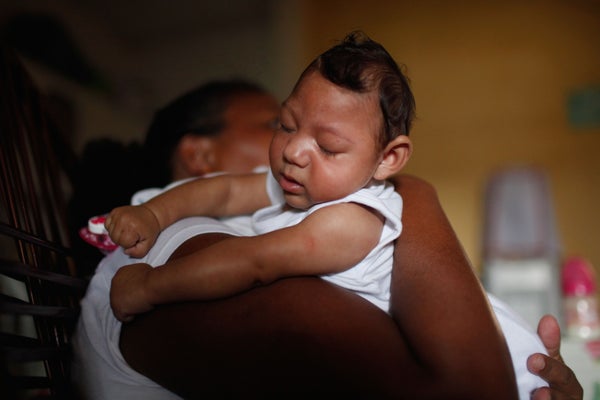U.S. public health officials are bracing for a wave of babies with severe Zika-related birth defects. The latest official numbers suggest 808 pregnant women in the U.S. appear to have been infected with Zika. Yet doctors are also steeling themselves for the possibility of birth abnormalities in another population: babies born to women who did not know they were infected. Preparing for the potential deluge—both physically and psychologically—remains daunting.
“There will be an extraordinary demand on special-needs care,” says Anthony Fauci, director of the National Institute of Allergy and Infectious Diseases (NIAID) at the National Institutes of Health. “You need to marshal a lot of special needs services to follow, diagnose and take care of these things as they evolve.” Families faced with serious birth defects may need a whole range of services including occupational therapy, physical therapy and other medical assistance. Already 21 infants have been born with Zika-related birth defects in the U.S. and five pregnancy losses have been linked to the disease. Clinicians are expecting those numbers to climb in the coming months. But the uncertainty makes planning difficult. Even among pregnant women with Zika it is impossible to estimate how many of their fetuses will develop abnormalities.
The potential surge in birth defects could extend far beyond the microcephaly (extremely small head size) often associated with mothers having the disease during pregnancy. Women may give birth to children with total or partial hearing loss, vision loss, joint deformities or serious neurological damage. But not all of these conditions would be immediately apparent at birth. It will be at least two years before doctors can get a good sense of the extent of the situation in the U.S., says Karin Nielsen-Saines, a pediatric infectious diseases specialist at the University of California, Los Angeles, who studies Zika.
On supporting science journalism
If you're enjoying this article, consider supporting our award-winning journalism by subscribing. By purchasing a subscription you are helping to ensure the future of impactful stories about the discoveries and ideas shaping our world today.
Late last month a team of NIAID researchers went to Brazil and saw troubling Zika-related birth defects among newborns there. Babies were unable to keep food down, had difficulty swallowing and were missing early-life developmental milestones, Fauci says. Right now there is no effective way to estimate how many of these same issues will show up among babies in the U.S. “It’s the unknown that is bothering me,” he says.
“What happens is we are skewed toward the obvious problems that require medical attention, like children with a very small head or no hearing at all—those conditions become obvious quickly but other issues like a delay in developmental milestones or vision issues may take time to characterize,” Nielsen-Saines says. “Children whose mothers are known to have had Zika should be followed very closely by developmental specialists and have frequent hearing and vision screens.”
Data on newborns in Colombia suggests that Zika-infected women who are asymptomatic may give birth to children with Zika-related abnormalities. With that in mind, the U.S. Centers for Disease Control and Prevention has recommended testing for Zika during routine obstetric care for pregnant women who may have been exposed to the virus.
But diagnosis of a prior infection remains difficult, says Karen Harris, a Gainesville, Fla.–based obstetrician who is overseeing Zika coordination in her state for the American Congress of Obstetricians and Gynecologists. “We know the testing window may be as short as 12 weeks” after infection, Harris says. “So there is no test we have that is able to let us look back long-term and say, ‘Aha, you had Zika!’”
This is “absolutely a limitation of current technology,” agrees CDC Director Tom Frieden, adding that there is no test for exposure beyond eight to 12 weeks. “This will be one of things we are trying to fund with the funds that were just approved,” he says, referring to emergency Zika support funds passed by Congress on September 28.
Reliable numbers on the long-term effects of Zika exposure in the womb will be a top research priority in the coming years. Nielsen-Saines plans to track more than 180 pregnant women exposed to the virus in Brazil to record their children’s outcomes. There is also a massive international effort, headed by Brazilian researchers and the NIH, to study around 10,000 Zika-affected pregnant women and their children. New pregnancy registries designed specifically to track Zika in the U.S. and its territories are also boosting such surveillance.
In Puerto Rico the Zika epidemic dwarfs that in the mainland U.S. Since 2015 laboratory tests have confirmed evidence of Zika exposure in 1,977 pregnant women in Puerto Rico (pdf). More than a third of them, however, (682) had not noticed any Zika symptoms. According to CDC figures, the outbreak trend in Puerto Rico suggests that at least one in four people—including women who become pregnant—may get infected with Zika.
Against this dire backdrop, last week the U.S. Congress green-lighted a $1.1-billion Zika funding bill after months of delay. It will support research on a Zika vaccine, better diagnostics and the public health response to the threat. Yet for children born with Zika-affected abnormalities in the current generation, crucial answers about the virus and how to stop it will have come too late.
